Introduction
Volcanic stone represents nature’s powerful artistry—born from the fiery depths of the Earth and transformed into versatile, durable material that has captivated humans for millennia. These igneous rocks form when molten lava cools and solidifies, creating distinctive textures, compositions, and properties that make them invaluable across numerous applications.
What makes volcanic stone particularly fascinating is not just its dramatic origin story, but its remarkable diversity. From the lightweight, bubble-filled pumice that floats on water to the glossy, sharp-edged obsidian that prehistoric cultures fashioned into tools, volcanic stone offers an incredible range of characteristics suited to countless uses in our modern world.
Whether you’re a homeowner considering a landscaping project, an architect seeking sustainable building materials, or simply curious about the Earth’s geological processes, understanding volcanic stone opens up a world of practical applications and scientific wonder.
Table of Contents
Formation and Geology
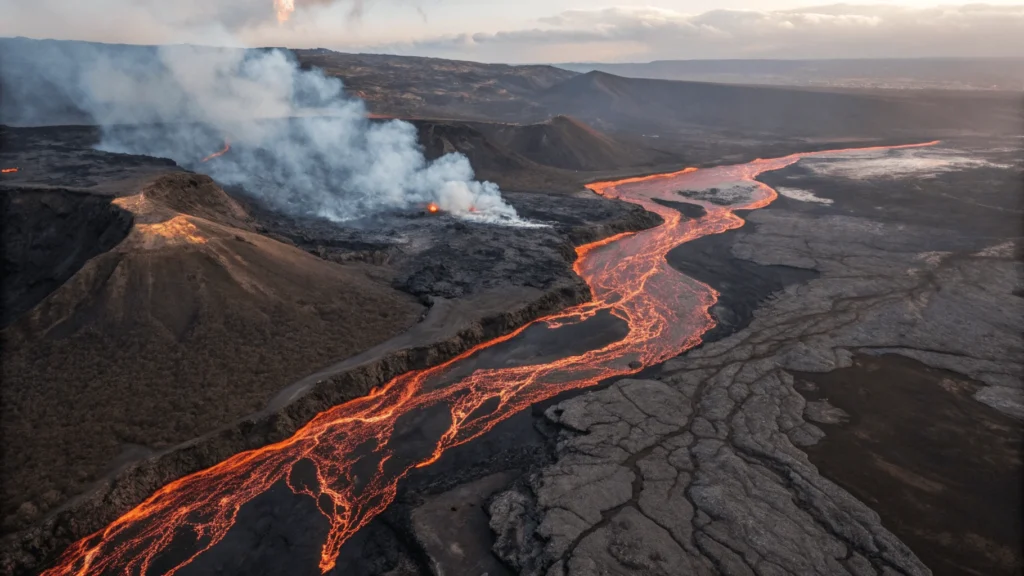
How Volcanic Rocks Form
Volcanic stone belongs to the broader category of igneous rocks, which form through the cooling and solidification of magma or lava. What distinguishes volcanic stones from other igneous rocks is their formation process:
Extrusive Formation: Most volcanic stones form extrustively—the magma erupts onto Earth’s surface as lava and cools quickly in contact with air or water. This rapid cooling prevents large crystals from developing, resulting in fine-grained or even glass-like textures. Examples include basalt, pumice, and obsidian.
Intrusive Formation: Some volcanic rocks form intrusively, when magma cools slowly beneath the Earth’s surface. These typically develop larger crystals due to the slower cooling process. While not strictly “volcanic” in the eruption sense, these igneous rocks are often found in volcanic regions and share similar mineral compositions.
The cooling rate significantly influences the final properties of volcanic stone. Rapid cooling creates rocks with smaller crystals or glassy textures, while slower cooling allows larger crystal formation. Additionally, the presence of gases in the magma creates vesicles (bubble-like cavities) in rocks like pumice and scoria.
Key Geological Processes
Several geological processes influence volcanic stone formation:
- Magma Composition: The mineral content of the original magma determines the type of volcanic stone. Basaltic magma has lower silica content and produces darker rocks, while rhyolitic magma contains more silica, creating lighter-colored stones.
- Gas Content: Magma containing high volumes of dissolved gases produces vesicular rocks with numerous cavities when the pressure decreases during eruption.
- Cooling Rate: As mentioned above, the speed at which lava cools dramatically impacts crystal formation and texture.
- Weathering and Alteration: After formation, volcanic stones continue to change through weathering, erosion, and in some cases, metamorphism, further enhancing their diversity.
Global Distribution
Volcanic stone is found worldwide, particularly along tectonic plate boundaries where volcanic activity is most prevalent:
- Pacific Ring of Fire: Encompasses volcanic regions around the Pacific Ocean, including Hawaii, Japan, the Philippines, New Zealand, and the western coasts of North and South America.
- Mediterranean Region: Italy (particularly around Mount Vesuvius and Mount Etna), Greece, and Turkey host significant volcanic stone deposits.
- East African Rift: Running through Ethiopia, Kenya, and Tanzania, this area features extensive volcanic activity and stone formations.
- Iceland: Sitting atop the Mid-Atlantic Ridge, Iceland is composed almost entirely of volcanic rock, offering some of the world’s most spectacular basalt formations.
- Indonesia: With over 130 active volcanoes, Indonesia produces abundant volcanic stone varieties.
These regions not only supply volcanic stone for commercial use but also serve as living laboratories for understanding geological processes and the Earth’s dynamic nature.
Types of Volcanic Stone
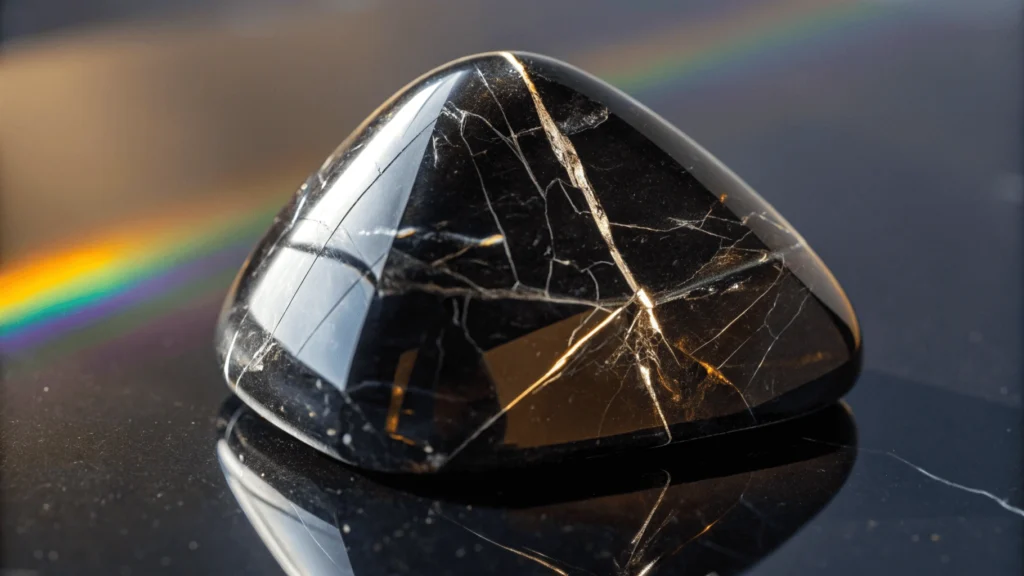
Volcanic stone encompasses several distinct varieties, each with unique properties and applications. Let’s explore the major types in detail:
Pumice
Properties:
- Extremely lightweight—often floats on water
- Highly porous with numerous small vesicles
- Typically light gray or white in color
- Relatively soft (5-6 on Mohs hardness scale)
- Very low density (0.25-0.91 g/cm³)
Common Uses:
- Personal Care: Exfoliation tools for removing dead skin cells and calluses
- Construction: Lightweight concrete aggregate, sound and thermal insulation
- Horticulture: Soil amendment to improve drainage and aeration
- Abrasives: Industrial cleaning and polishing compounds
- Filtration: Water filtration systems and pool filters
Pumice’s exceptional lightness comes from gas bubbles trapped in the lava as it rapidly cools, creating a stone that’s up to 90% air by volume.
Obsidian
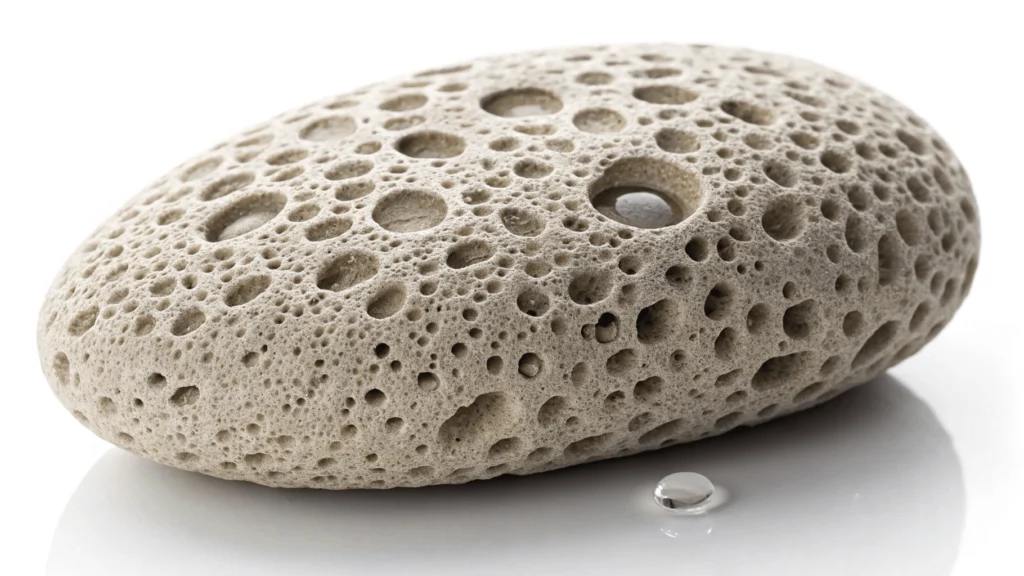
Properties:
- Glass-like appearance with conchoidal fracture pattern
- Extremely sharp edges when broken
- Usually black, but can appear brown, green, or even rainbow-colored
- Non-porous and completely solid
- High silica content (>70%)
Common Uses:
- Historical Tools: Prized by ancient civilizations for crafting sharp cutting implements and weapons
- Modern Jewelry: Polished into beads, cabochons, and decorative pieces
- Surgical Instruments: Historically used for precise cutting instruments; obsidian blades can be sharper than steel
- Decorative Arts: Sculptures, decorative objects, and interior design elements
- Arrowheads: Historical and modern crafting of arrow and spear points
Obsidian forms when lava with high silica content cools so rapidly that no crystallization occurs, creating a natural glass.
Basalt
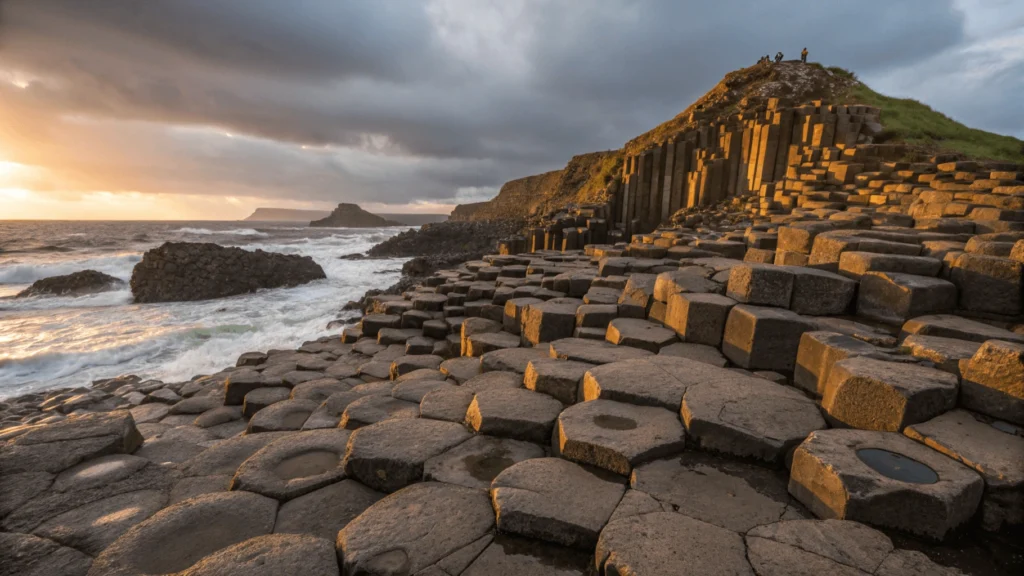
Properties:
- Dense and fine-grained
- Dark gray to black in color
- Extremely durable and weather-resistant
- High compressive strength
- Often displays columnar jointing in nature
Common Uses:
- Construction: Building facades, flooring, countertops, and paving stones
- Crushed Stone: Road base, railroad ballast, and concrete aggregate
- Architectural Features: Columns, wall cladding, and decorative elements
- Thermal Mass: Heat retention in passive solar designs
- Stone Wool: Processed into heat-resistant insulation
- Sculptures: Outdoor art pieces and monuments
Basalt is the most abundant volcanic rock on Earth, making up much of the ocean floor and forming spectacular natural formations like the Giant’s Causeway in Ireland and Devil’s Postpile in California.
Scoria/Lava Rock
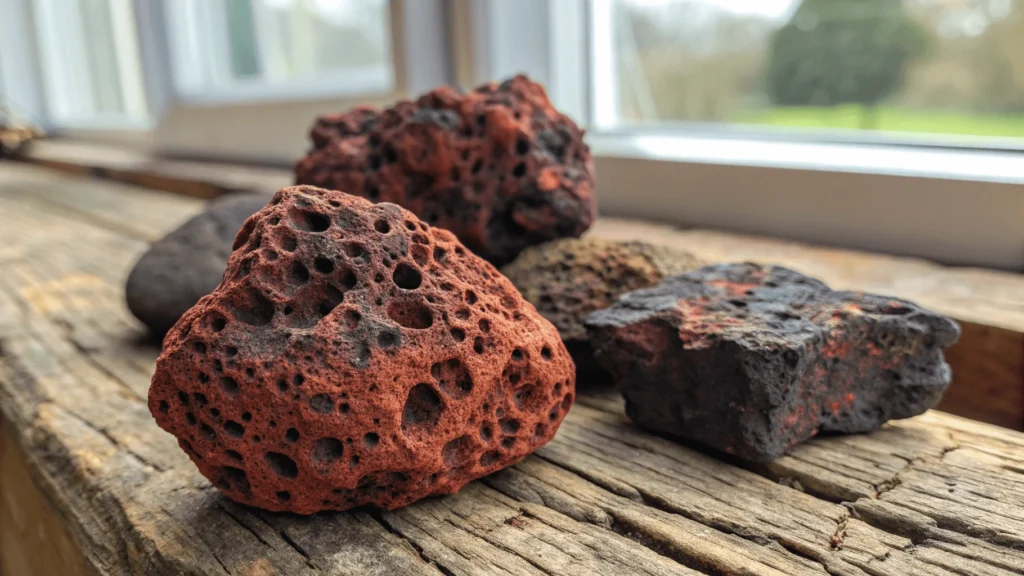
Properties:
- Vesicular texture with larger, irregular holes than pumice
- Typically reddish-brown to black in color
- Moderate density—heavier than pumice but lighter than basalt
- Rough, jagged surface texture
- Good heat resistance
Common Uses:
- Landscaping: Decorative ground cover, drainage material, and mulch
- BBQ Grills: Heat diffusion in gas grills
- Drainage Systems: French drains and filtration beds
- Aquariums: Natural-looking aquascapes and biological filtration
- Lightweight Aggregate: Construction materials requiring reduced weight
- Bonsai Cultivation: Growing medium for specialized plant cultivation
Scoria forms when lava with moderate gas content cools quickly. Its vesicles are generally larger and less uniform than those in pumice.
Other Volcanic Rock Types
Andesite
- Medium-gray to dark gray in color
- Intermediate silica content between basalt and rhyolite
- Often found in composite volcanoes
- Used in construction aggregates and decorative stone
Rhyolite
- Light-colored with pinkish or grayish tones
- High silica content similar to granite
- Often displays flow banding patterns
- Used for decorative stone and as building material
Dacite
- Gray to light brown with a fine-grained texture
- Intermediate composition between andesite and rhyolite
- Often contains visible quartz crystals
- Used in construction and as decorative stone
Comparison Table: Volcanic Stone Types
| Type | Appearance | Density | Porosity | Main Uses | Best For |
|---|---|---|---|---|---|
| Pumice | Light gray/white, highly vesicular | Very low | Very high | Exfoliation, lightweight concrete, horticulture | Applications requiring lightweight, porous material |
| Obsidian | Black/dark, glassy | High | Very low | Jewelry, cutting tools, decorative items | Sharp edges, decorative applications |
| Basalt | Dark gray/black, fine-grained | High | Low | Construction, paving, countertops | Durable, weather-resistant applications |
| Scoria | Reddish-brown/black, vesicular | Medium | High | Landscaping, BBQ grills, drainage | Heat-resistant, drainage applications |
| Andesite | Medium gray, porphyritic | Medium-high | Low | Construction aggregates, decorative stone | Intermediate durability applications |
| Rhyolite | Light colored, flow-banded | Medium | Low-medium | Decorative stone, construction | Aesthetic applications requiring lighter colors |
| Dacite | Gray/light brown, fine-grained | Medium-high | Low | Construction, decorative stone | Applications between andesite and rhyolite properties |
Properties of Volcanic Stone
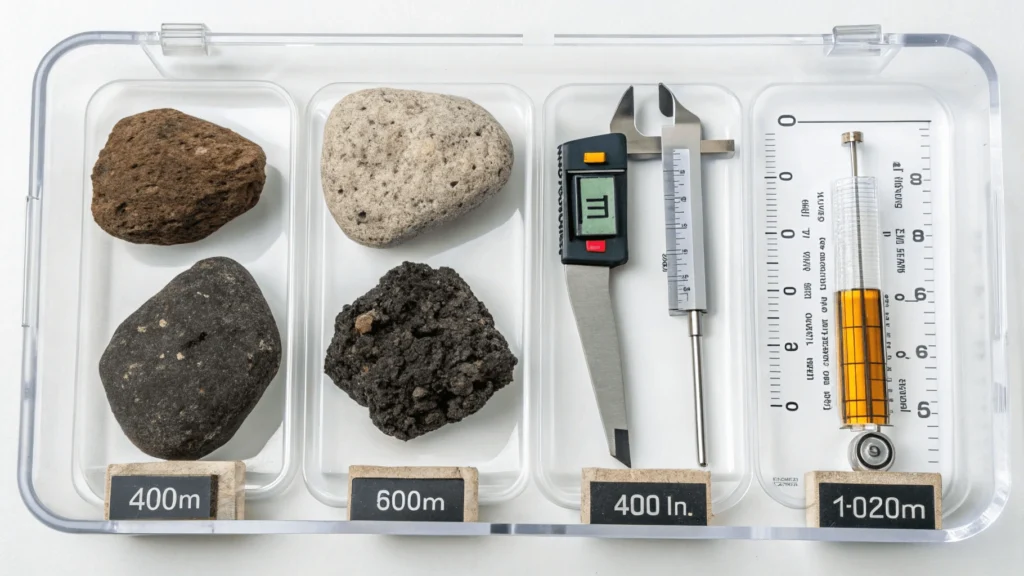
Understanding the physical and chemical properties of volcanic stone helps explain its versatility across different applications:
Texture
Volcanic stones exhibit several distinctive textures:
- Aphanitic: Fine-grained texture where individual minerals cannot be seen with the naked eye. This results from rapid cooling that prevents crystal growth. Basalt typically displays this texture.
- Glassy: Complete absence of crystals, resulting in a smooth, glass-like appearance. Obsidian exemplifies this texture.
- Vesicular: Characterized by numerous bubble-like cavities (vesicles) formed by gas escaping during solidification. Pumice and scoria feature this texture.
- Porphyritic: Contains larger crystals (phenocrysts) embedded in a fine-grained or glassy groundmass. This texture indicates two-stage cooling, where some crystals formed slowly before the remaining magma cooled rapidly.
Porosity and Water Absorption
Porosity varies dramatically among volcanic stones:
- High Porosity: Pumice and scoria can have porosity exceeding 50%, allowing them to absorb significant amounts of water. This property makes them excellent for drainage applications but potentially problematic in freeze-thaw environments.
- Low Porosity: Obsidian and dense basalt have minimal porosity (often less than 1%), making them highly resistant to water absorption. This characteristic enhances their durability in wet environments and reduces susceptibility to freeze-thaw damage.
The porosity directly influences applications—highly porous volcanic stones work well for filtration and soil amendment, while low-porosity varieties excel in construction and outdoor applications.
Density and Weight
Density correlates inversely with porosity:
- Low Density: Pumice typically ranges from 0.25 to 0.91 g/cm³, often light enough to float on water.
- Medium Density: Scoria and some vesicular basalts range from 1.0 to 2.5 g/cm³.
- High Density: Dense basalt, obsidian, and non-vesicular volcanic rocks typically range from 2.5 to 3.1 g/cm³.
These density variations make volcanic stone suitable for different applications—lightweight varieties for insulation and soil amendment, and denser types for construction and ballast.
Hardness and Durability
Volcanic stones exhibit various hardness levels:
- Pumice: 5-6 on the Mohs scale
- Basalt: 5-7 on the Mohs scale
- Obsidian: 5-5.5 on the Mohs scale
- Scoria: 5-6 on the Mohs scale
Despite similar hardness values, their practical durability varies significantly due to structural differences. Dense basalt resists abrasion and crushing, making it ideal for high-traffic areas like paving stones. Pumice, despite similar hardness, abrades more easily due to its porous structure.
Heat Resistance
Volcanic stones generally offer excellent heat resistance, reflecting their high-temperature origins:
- Most can withstand temperatures exceeding 900°C (1650°F) without structural damage
- Basalt remains stable at high temperatures, making it suitable for fireplaces and heat retention
- Scoria’s heat resistance makes it popular in gas grills and fire pits
- Some volcanic stones undergo color changes when heated before experiencing structural damage
Color Variations
The color spectrum of volcanic stone reflects its mineral composition and formation conditions:
- Black to Dark Gray: Typically indicates high iron and magnesium content (basalt, obsidian)
- Red to Brown: Often results from iron oxidation (many scoria varieties)
- Light Gray to White: Usually indicates higher silica content (pumice, some rhyolites)
- Green Tints: May indicate minerals like olivine or chlorite
- Multiple Colors: Some obsidian displays bands of different colors from mineral variations during formation
The diverse color palette makes volcanic stone aesthetically versatile across decorative applications while also serving as an indicator of composition and formation conditions.
Applications & Uses
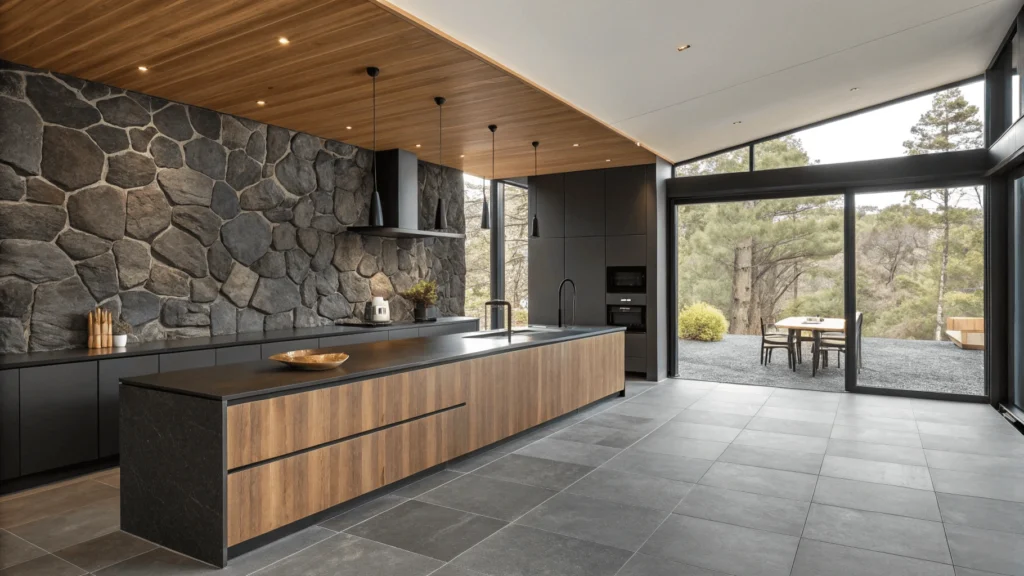
Construction & Architecture
Volcanic stone has become increasingly popular in modern construction due to its durability, aesthetic appeal, and sustainable properties:
- Building Facades: Basalt tiles and panels provide weather-resistant, low-maintenance exterior cladding with natural thermal insulation properties.
- Flooring: Polished basalt and andesite create elegant, durable flooring options that withstand heavy traffic while providing natural thermal mass for passive heating and cooling.
- Countertops: Basalt’s dense, non-porous nature makes it an excellent alternative to granite for kitchen and bathroom countertops, offering a unique matte finish that resists staining.
- Aggregates: Crushed volcanic stone serves as lightweight aggregate in specialty concretes, reducing structural weight while maintaining strength.
- Wall Construction: In some regions, shaped volcanic blocks form traditional building materials, offering natural insulation and fire resistance.
“The thermal properties of volcanic stone make it an increasingly popular choice among architects seeking sustainable building materials that reduce energy consumption while providing distinctive aesthetic appeal.” – Contemporary Architecture Review
Landscaping
The varied textures, colors, and properties of volcanic stone make it a landscaper’s dream material:
- Mulch: Scoria and lava rock provide decorative ground cover that doesn’t decompose, inhibits weed growth, and improves drainage.
- Decorative Boulders: Larger volcanic specimens create striking focal points in landscape designs.
- Pathways: Crushed volcanic stone creates permeable, stable path surfaces with excellent drainage.
- Water Features: Basalt columns and volcanic boulders form natural-looking waterfalls and water garden features.
- Rock Gardens: The porous nature of some volcanic rocks supports specialized plant growth while providing distinctive texture and color.
- Erosion Control: Volcanic stone’s durability and weight make it effective for stabilizing slopes and controlling erosion.
Jewelry & Adornment
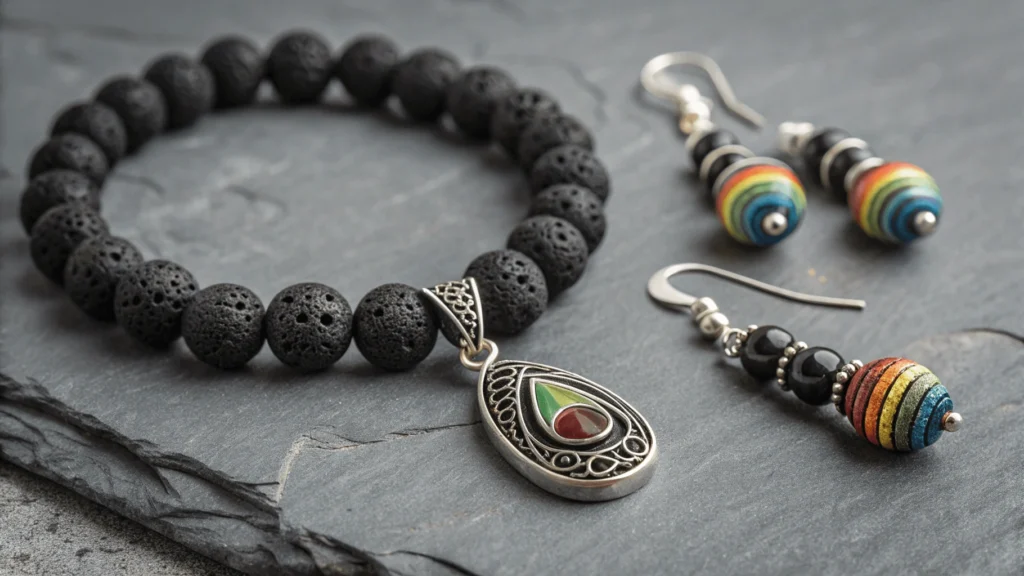
The unique properties of certain volcanic stones have made them prized materials in jewelry making:
- Lava Stone Beads: Porous black beads often used in diffuser jewelry for essential oils.
- Obsidian Pendants: Polished obsidian creates striking jewelry with deep luster and sometimes multicolored reflections (rainbow obsidian).
- Carved Figurines: Softer volcanic stones can be carved into decorative sculptures and figurines.
- Inlay Work: Thin slices of colorful volcanic stone provide distinctive inlays in furniture and decorative objects.
- Beachstone Jewelry: Tumbled volcanic stones from beaches create natural, smooth beads with unique patterns.
Wellness & Beauty
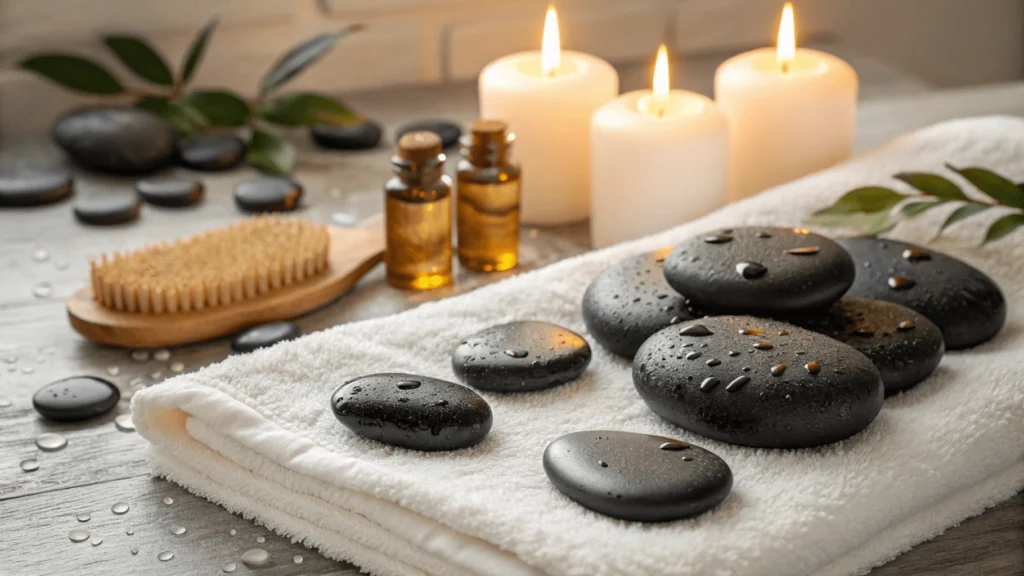
Volcanic stone plays a surprising role in personal care and wellness practices:
- Pumice Stones: Natural exfoliators for removing calluses and dead skin cells.
- Hot Stone Massage: Basalt stones retain heat effectively for therapeutic massage.
- Facial Treatments: Volcanic ash (finely ground volcanic stone) appears in clarifying masks and exfoliants.
- Spa Decor: Volcanic stone creates aesthetically pleasing, naturally antimicrobial surfaces in spa environments.
- Saunas: Volcanic stone’s heat retention properties make it useful in sauna construction and as heating elements.
Horticulture & Aquariums
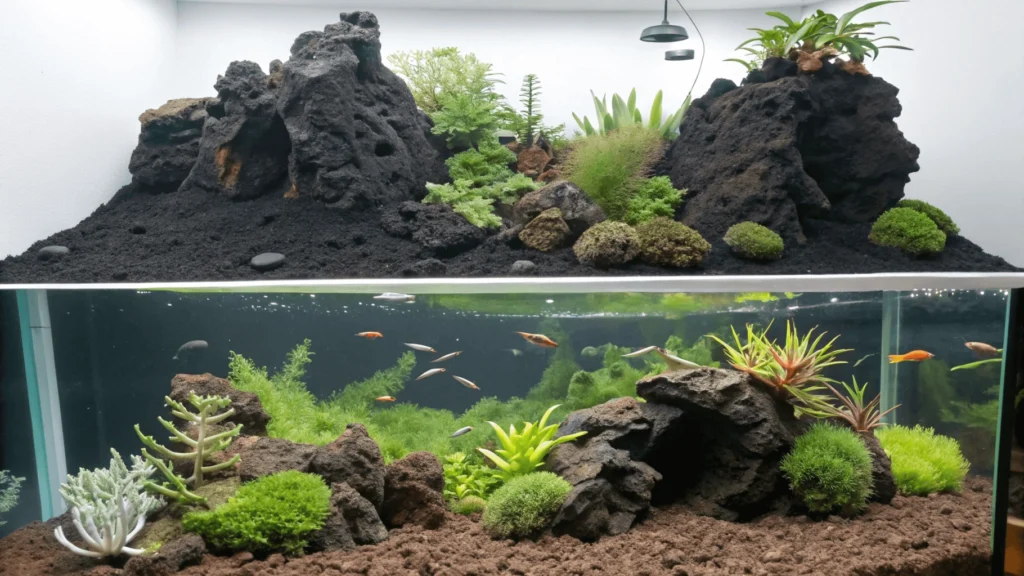
The unique properties of volcanic materials benefit plants and aquatic environments:
- Soil Amendments: Pumice improves soil aeration and drainage while providing mild water retention.
- Hydroponics: Expanded volcanic clay pellets serve as growing medium in hydroponic systems.
- Bonsai Culture: Specialized volcanic soils support bonsai cultivation.
- Aquarium Hardscape: Lava rock provides natural-looking structure in aquariums while hosting beneficial bacteria.
- Plant Propagation: Pumice and perlite (a processed volcanic glass) create ideal propagation mediums for cuttings.
- Mulch Alternative: Scoria serves as a long-lasting, decorative mulch that improves drainage around plants.
Industrial Uses
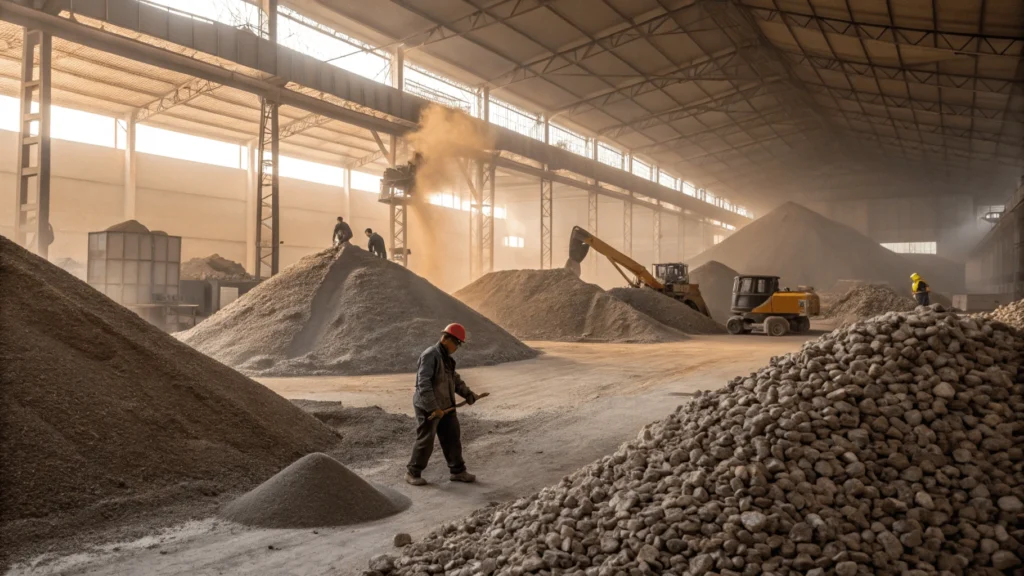
Volcanic stone’s unique properties serve numerous industrial applications:
- Lightweight Concrete: Pumice aggregate creates concrete with enhanced insulation properties and reduced weight.
- Insulation: Processed volcanic stone forms mineral wool for high-temperature insulation.
- Abrasives: Pumice powder serves as a mild abrasive in polishing compounds and cleaners.
- Filtration Media: Crushed volcanic stone filters water and other liquids in industrial and municipal systems.
- Road Construction: Crushed basalt provides durable road base material and asphalt aggregate.
- Refractory Materials: Heat-resistant volcanic materials line kilns and furnaces.
Historical & Cultural Significance
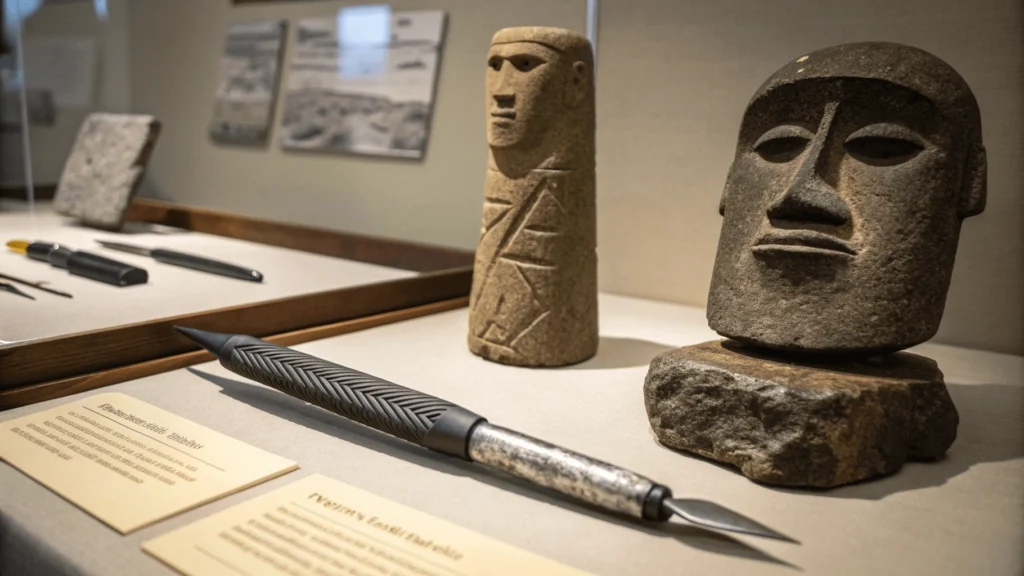
Throughout human history, volcanic stone has played important cultural and practical roles:
- Tools: Obsidian provided some of humanity’s earliest and sharpest cutting tools.
- Monuments: Ancient civilizations constructed monumental works from volcanic stone, from the moai of Easter Island to Roman structures built with tufa (a volcanic ash stone).
- Grinding Implements: Basalt’s durability made it ideal for mortars, pestles, and grinding stones.
- Religious Significance: Many cultures associated volcanic stones with divine power, using them in ceremonial contexts.
- Art: From ancient times to present day, sculptors have crafted volcanic stone into artistic expressions.
- Writing Surfaces: Some ancient cultures used volcanic tablets for recording information.
Volcanic Stone vs. Lava Stone vs. Igneous Rock: Clarifying Terminology
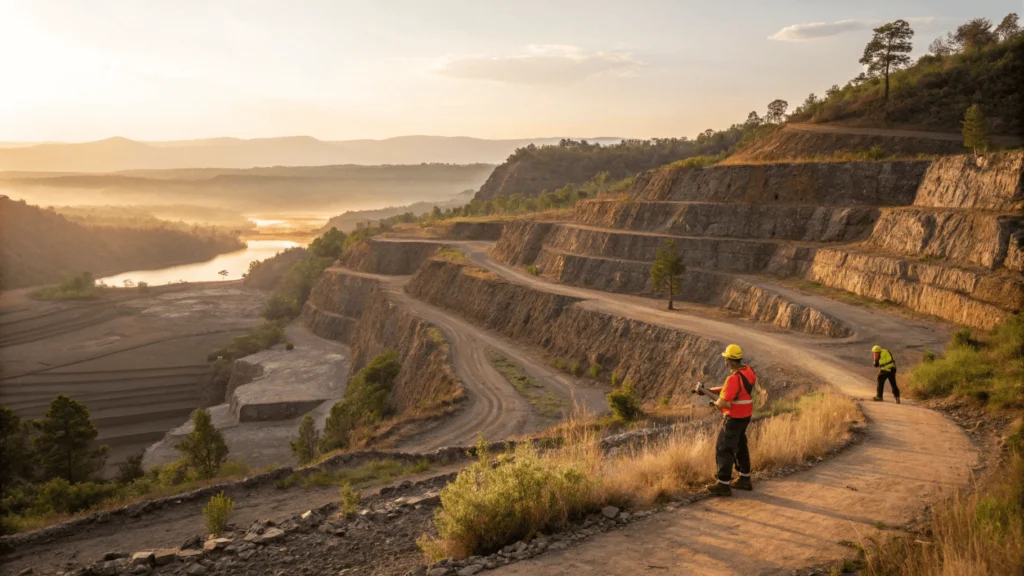
The terms “volcanic stone,” “lava stone,” and “igneous rock” are often used interchangeably, but they have distinct meanings:
Volcanic Stone: Refers specifically to rock formed from lava that reached Earth’s surface before cooling and solidifying. The term encompasses multiple rock types including basalt, pumice, obsidian, and scoria.
Lava Stone: Generally synonymous with volcanic stone, though sometimes used more specifically to refer to vesicular basalt or scoria with obvious “lava-like” appearance. In the marketplace, “lava stone” often describes black, vesicular stones used in jewelry or décor.
Igneous Rock: The broader category that includes all rocks formed from the cooling and solidification of magma or lava. This includes both:
- Volcanic/Extrusive Igneous Rocks: Formed from lava at Earth’s surface (all volcanic stones)
- Plutonic/Intrusive Igneous Rocks: Formed from magma cooling below Earth’s surface (granite, diorite, gabbro)
This distinction explains why granite, though an igneous rock, is not considered a volcanic stone—it forms deep underground rather than from surface lava flows.
Sourcing and Sustainability
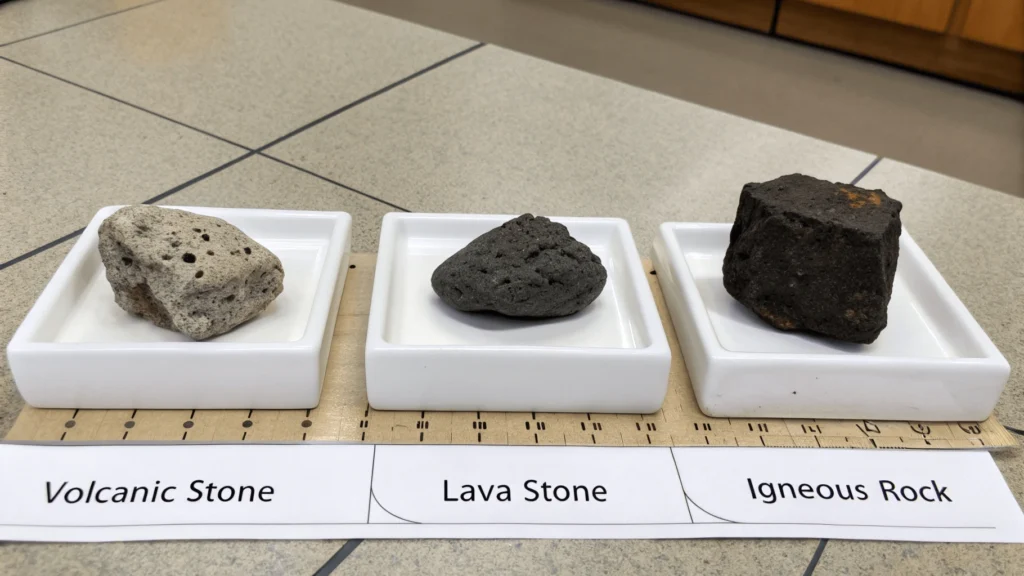
Where to Find Volcanic Stone Products
Volcanic stone products are available through various channels:
- Building Supply Centers: Often carry basalt tiles, pavers, and landscaping stone
- Landscaping Suppliers: Specialize in volcanic mulch, decorative boulders, and pathway materials
- Specialty Stone Retailers: Offer higher-end volcanic stone for countertops and architectural features
- Beauty Supply Stores: Carry pumice stones for personal care
- Jewelry Suppliers: Stock lava beads and obsidian for jewelry making
- Aquarium Stores: Provide lava rock specifically treated for aquatic use
- Garden Centers: Offer volcanic soil amendments and decorative stone
- Online Marketplaces: Provide access to the full range of volcanic stone products
Sustainability Considerations
When sourcing volcanic stone, consider these sustainability factors:
Positive Environmental Aspects:
- Extremely durable, providing long service life
- Requires minimal processing compared to manufactured alternatives
- Contains no toxic chemicals or off-gassing potential
- Can be recycled or repurposed at end of use
- Natural thermal properties can reduce energy consumption in buildings
Potential Concerns:
- Quarrying impact on landscapes, especially in sensitive ecological areas
- Transportation carbon footprint when sourced from distant locations
- Some volcanic habitats host unique ecosystems that could be disrupted by extraction
- Limited renewability—while abundant, volcanic stone is ultimately a finite resource
Sustainable Sourcing Tips:
- Look for suppliers who practice responsible quarrying with site restoration plans
- Choose locally sourced volcanic stone when possible to reduce transportation impacts
- Consider reclaimed or repurposed volcanic stone for certain applications
- Verify that decorative stone wasn’t harvested from protected areas
- For landscaping, calculate appropriate quantities to avoid waste
Care and Maintenance
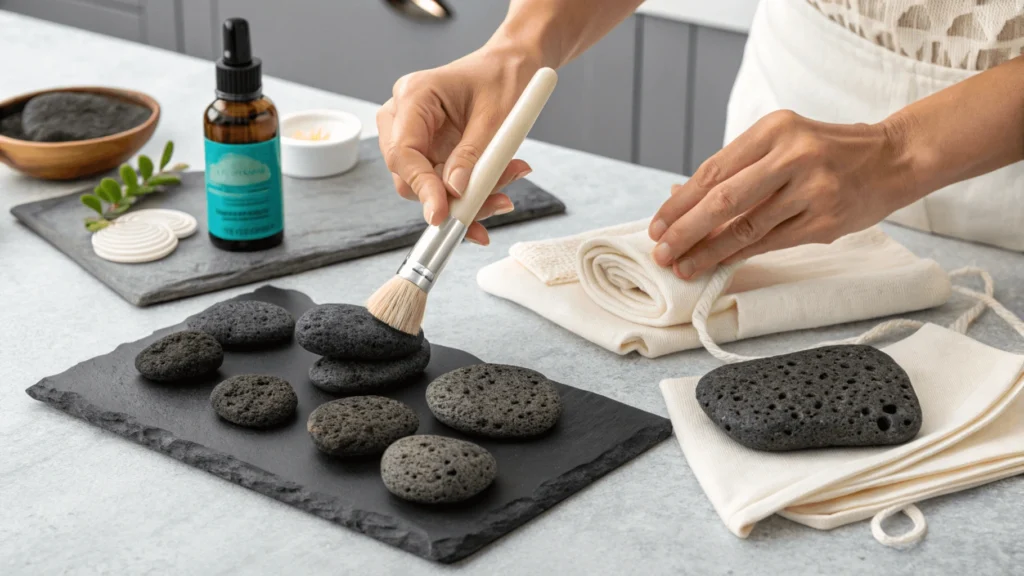
Proper care ensures volcanic stone products maintain their appearance and functionality for years:
For Construction Applications (Countertops, Floors, Facades)
- Sealing: Most dense volcanic stone benefits from periodic sealing with appropriate stone sealers to prevent staining, particularly in kitchen and bathroom applications.
- Cleaning: Use pH-neutral stone cleaners rather than acidic or highly alkaline products, which can etch or damage volcanic stone surfaces.
- Scratch Prevention: While durable, volcanic stone can scratch. Use cutting boards on countertops and furniture pads under heavy objects on flooring.
- Stain Removal: Address spills promptly, especially on more porous varieties. For existing stains, use poultices designed for natural stone rather than harsh chemicals.
- Polishing: Maintain glossy finishes with specific stone polishing products rather than general-purpose polishes that may contain damaging components.
For Landscaping Applications

- Weed Control: Place landscape fabric beneath volcanic mulch to minimize weed growth through the material.
- Cleaning: Periodically rinse decorative volcanic stone with plain water to remove dust and debris. For more stubborn dirt, gentle pressure washing is typically safe.
- Containment: Use edging to keep volcanic stone mulch and pathway materials contained in designated areas.
- Replacement: Top up volcanic mulch every few years as minor settling occurs, though significantly less frequently than organic mulches.
- Winter Care: In freeze-thaw climates, be aware that water trapped in porous volcanic landscape stone can freeze and potentially cause cracking.
For Jewelry and Decorative Items
- Cleaning Lava Stone Beads: Clean with mild soap and water using a soft cloth or brush; avoid soaking porous varieties.
- Obsidian Care: Clean with soft, damp cloth; avoid temperature extremes that could cause cracking.
- Essential Oil Use: When using lava stone for essential oil diffusing jewelry, allow complete drying between oil applications and periodically clean with mild soap to prevent buildup.
- Storage: Store volcanic stone jewelry separately from harder gemstones to prevent scratching, particularly for polished pieces.
Conclusion
Volcanic stone represents one of nature’s most versatile materials, offering remarkable diversity in appearance, properties, and applications. From the lightweight porosity of pumice to the dense strength of basalt and the glass-like beauty of obsidian, these stones connect us directly to Earth’s dynamic geological processes.
The enduring popularity of volcanic stone across both ancient and modern contexts speaks to its practical advantages—durability, sustainability, unique aesthetic appeal, and specialized physical properties that serve countless applications. As we continue to seek sustainable, natural materials for our built environments and personal spaces, volcanic stone remains a compelling option that combines practicality with distinctive character.
Whether you’re considering volcanic stone for a construction project, landscaping application, wellness routine, or decorative purpose, understanding the specific properties of each variety ensures you’ll select the right stone for your needs. With proper care, volcanic stone products can last generations, providing both functionality and natural beauty.

FAQ Section
What is the difference between pumice and lava rock?
Pumice and lava rock (scoria) are both vesicular volcanic stones, but pumice is significantly lighter and more porous, often light enough to float on water. Pumice typically appears light gray or white, while lava rock/scoria is usually darker reddish-brown or black with larger, less uniform vesicles. Pumice forms from high-silica lava with high gas content that cools extremely rapidly.
Is lava stone heavy?
Lava stone’s weight varies significantly by type. Pumice is exceptionally lightweight (often floating on water), while scoria (commonly called lava rock) has moderate density. Dense basalt is quite heavy, comparable to granite. For landscaping and construction projects, weight considerations are important for transportation and structural support requirements.
Can volcanic rock get wet?
Yes, volcanic rock can get wet, but different types react differently to moisture. Dense varieties like basalt and obsidian are minimally affected by water exposure. Porous types like pumice and scoria absorb water, which can be problematic in freeze-thaw environments where trapped water might expand and crack the stone. In landscape applications, volcanic rock’s water permeability is often beneficial for drainage.
How is volcanic stone formed?
Volcanic stone forms when molten lava erupts from a volcano and cools, solidifying into rock. The specific properties of each type depend on the lava’s mineral composition, gas content, and cooling rate. Rapid cooling creates fine-grained or glassy textures (like obsidian), while lava with high gas content forms porous stones like pumice when gases escape during cooling.
Is obsidian actually volcanic glass?
Yes, obsidian is genuine volcanic glass. Unlike most rocks that consist of crystalline minerals, obsidian forms when silica-rich lava cools so rapidly that mineral crystals cannot form, resulting in a glass-like material. This natural glass can be incredibly sharp when fractured, creating edges finer than modern surgical steel.
What makes pumice float on water?
Pumice floats because it contains numerous sealed air pockets created when gases became trapped in the rapidly cooling lava. These air pockets make pumice less dense than water, allowing it to float until the vesicles eventually fill with water over time. This unique property has enabled pumice rafts to transport plant seeds and potentially small organisms across oceans.
How do I clean volcanic stone countertops?
Clean volcanic stone countertops with pH-neutral stone cleaners and soft cloths. Avoid acidic cleaners (including vinegar), abrasive scrubbers, and harsh chemicals that can etch or damage the surface. Wipe up spills promptly to prevent staining, especially on more porous varieties. Apply an appropriate stone sealer according to the manufacturer’s recommendations to maintain protection.
Can I use lava rock in my garden?
Yes, lava rock (typically scoria) makes an excellent garden mulch and decorative element. It provides good drainage, doesn’t decompose like organic mulch, discourages weed growth, and can help retain soil moisture by reducing evaporation. The stone’s porous nature can also provide habitat for beneficial microorganisms. For plants requiring acidic soil, verify the volcanic stone’s pH compatibility.


